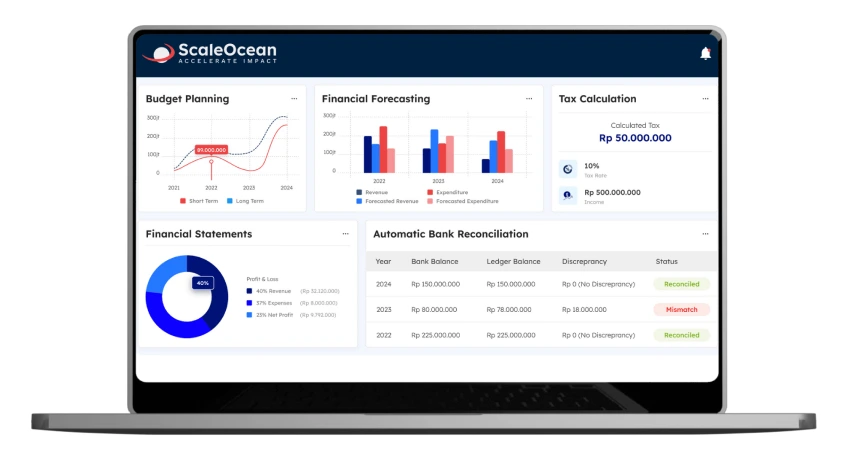A financial audit is a critical process for businesses, ensuring that financial statements are accurate, compliant with regulations, and reliable for stakeholders. Companies depend on audits to verify financial integrity, detect errors or fraud, and maintain transparency in their operations. Whether conducted internally or by external auditors, a financial audit provides an objective review of records, accounting policies, and financial transactions to assess compliance and financial stability.
Understanding the audit process and best practices can help businesses strengthen financial controls, mitigate risks, and improve decision-making. In this article, we will break down the key aspects of financial audits, their significance in business operations, and how to conduct them effectively. By the end, you’ll have a clear strategy for maintaining compliance and ensuring financial accountability.
- A financial audit is an independent examination of a company’s financial statements to ensure accuracy, transparency, and compliance with accounting standards.
- The financial audit process involves planning, fieldwork, reporting, and follow-up stages to identify discrepancies and strengthen financial stability.
- Financial audits help businesses detect errors, prevent fraud, and increase trust among stakeholders, contributing to better decision-making.
- ScaleOcean accounting software streamlines financial audits with automation, real-time tracking, and seamless integration.

What is Financial Audit
A financial audit is an independent examination of a company’s financial statements and records to ensure accuracy, reliability, and compliance with relevant laws and accounting standards. It helps businesses verify that their financial information is free from material misstatements, whether due to errors or fraud.
Conducted by internal or external auditors, the process involves reviewing transactions, financial reports, and internal controls. A financial audit improves transparency, boosts stakeholder confidence, and ensures regulatory compliance, making it critical for businesses that want to maintain credibility and make sound financial decisions.
The Importance of Financial Audits for Businesses

Financial audits are required to ensure accuracy, compliance, and transparency in a business’ financial records. They help detect errors, prevent fraud, and ensure company adhere to accounting regulations, reducing financial and legal risks.
Audits can increase trust among stakeholders, such as investors, regulators, and business partners, by ensuring the accuracy of financial statements. Furthermore, they offer useful insights for enhancing internal controls and financial management. Regular audits improve credibility, help with decision-making, and contribute to long-term corporate stability.
Types of Financial Audits
There are various types of financial audits, each designed to ensure accuracy, compliance, and transparency in financial reporting. Knowing these audit types helps businesses manage risks, strengthen controls, and build stakeholder confidence. The three primary types of financial audits include as explained below.
1. External Audits
External audits are conducted by independent auditors to provide an objective assessment of an organization’s financial statements. These audits ensure that Singapore accounting standards and regulatory obligations are met, providing confidence to investors, lenders, and regulatory agencies. External audits improve openness and stakeholder confidence by ensuring financial accuracy and detecting irregularities.
2. Internal Audits
Internal audits are performed by a business’ internal team to assess financial controls, risk management, and governance processes. Unlike external audits, these are ongoing assessments aimed at improving operational efficiency and preventing fraud. Internal audits help businesses identify weaknesses, enhance internal controls, and ensure that financial practices align with organizational goals and regulatory requirements.
3. Forensic Audits
Forensic audits focus on investigating financial discrepancies, fraud, or legal violations within an organization. These audits include a thorough financial study to detect wrongdoing such as embezzlement, asset misappropriation, or financial statement fraud. Often used in legal proceedings, forensic audits help businesses uncover financial irregularities and strengthen fraud prevention measures.
Also read: What Is Accrual Accounting and Its Types
Stages of a Business Financial Audit
In businesses, financial audit process is divided into several stages, each with the objective of ensuring financial reporting accuracy, compliance, and transparency. These stages assist auditors in systematically evaluating financial statements, identifying risks, and making recommendations for improvement. A financial audit consists of four main stages as follows.
1. Planning
The planning stage involves defining the audit scope, objectives, and methodology. Auditors review financial records, assess risk areas, and establish a structured approach for the audit. This stage ensures that auditors focus on key financial aspects, comply with regulatory standards, and create an efficient audit plan tailored to the organization’s needs.
2. Fieldwork
During fieldwork, auditors gather and analyze financial data, test internal controls, and identify potential discrepancies. This phase includes examining transactions, verifying financial records, and interviewing key personnel. Fieldwork is crucial for detecting errors, fraud, or inefficiencies, ensuring that financial statements reflect an accurate and fair representation of the organization’s financial health.
3. Reporting
The reporting stage involves documenting audit findings, conclusions, and recommendations in an official audit report. Auditors summarize their observations, highlight compliance issues, and provide actionable insights. By utilizing ERP software for financial services, auditors can streamline the documentation process, ensuring accuracy and efficiency. The final report helps stakeholders understand financial risks, operational weaknesses, and areas for improvement, enabling better decision-making and financial transparency.
4. Follow-up
The follow-up stage ensures that corrective actions are implemented based on audit findings. Auditors review whether management has addressed identified issues and strengthened internal controls. This step is essential for continuous improvement, regulatory compliance, and reducing future financial risks, helping organizations maintain long-term financial integrity and accountability.
Key Components of a Financial Audit
A financial audit is a thorough process that evaluates an organization’s financial statements and practices. Key components of a financial audit ensure accuracy, transparency, and compliance while identifying potential risks and inefficiencies. These components include audit planning, risk assessment, internal control evaluation, and substantive testing. For a practical illustration of these concepts, you can refer to a profit and loss statement example to see how financial data is typically structured and audited.
1. Audit Plan
The audit plan serves as a roadmap, outlining the audit’s objectives, scope, and procedures. It provides auditors with a structured approach, ensuring that all areas of financial reporting are covered. The plan also includes timelines, resources, and the roles of the audit team to ensure a smooth process.
2. Risk Assessment
Risk assessment involves identifying areas of financial statements that have a higher likelihood of material misstatement. This step helps auditors focus their efforts on critical areas, considering factors like complexity, industry regulations, and previous audit findings. It guides the audit process and prioritizes areas that need more scrutiny.
3. Internal Control Evaluation
Internal control evaluation is a critical step in ensuring the integrity of a company’s financial reporting. Auditors assess the effectiveness of policies and procedures designed to prevent errors or fraud. They focus on internal controls over financial reporting and review how well the organization follows its established practices.
4. Substantive Testing
Substantive testing involves verifying the accuracy of financial information by performing detailed tests on transactions and balances. This stage helps auditors gather evidence to confirm the validity of financial statements. Substantive testing can include checking documentation, reviewing accounts, and sampling transactions to ensure financial data’s integrity.
How to Conduct a Financial Audit

Conducting a financial audit involves a structured approach to ensure accuracy, compliance, and transparency in financial reporting. Each step plays an important role in identifying risks, verifying financial data, and improving internal controls. Using the best financial accounting software in Singapore can streamline this process, making it more efficient. The key steps in conducting a financial audit include.
1. Preparation
The preparation stage involves gathering necessary financial documents, understanding the organization’s operations, and setting audit objectives. Auditors examine financial accounts, procedures, and previous audits to develop a clear audit strategy. Proper preparation enables a seamless audit process, allowing auditors to concentrate on critical financial areas and any compliance concerns.
2. Risk Assessment
Auditors use risk assessment to identify areas that are most vulnerable to errors, fraud, or misstatements. This step entails analyzing financial data, auditing internal controls, and determining regulatory compliance. By identifying high-risk areas, auditors can focus their efforts and create effective audit procedures to ensure financial integrity and reduce potential discrepancies.
3. Testing
During the testing phase, auditors perform detailed examinations of financial transactions and internal controls. This includes verifying account balances, reviewing supporting documentation, and conducting analytical procedures. Testing ensures that financial data is accurate, complete, and compliant with accounting standards, helping organizations detect potential errors or fraudulent activities.
4. Reporting
The reporting phase entails compiling audit findings into a comprehensive audit report. This report includes key observations, compliance concerns, and suggestions for improvement. It is an invaluable resource for management and stakeholders, providing insights into financial performance, operational risks, and areas that need to be addressed.
5. Follow-up
Follow-up is the last step in ensuring that recommended changes and corrective actions are carried out correctly. Auditors determine whether management has addressed identified weaknesses and improved financial controls. Regular follow-ups help organizations improve compliance, increase financial accountability, and avoid recurring problems in future audits.
Limitations of Financial Audits
While financial audits are necessary to ensure accuracy and compliance, they have some limitations that can reduce their effectiveness. These limitations are caused by time constraints, reliance on management, and the possibility of undetected fraud. Understanding the following challenges allows businesses to take additional steps to improve financial oversight.
1. Scope Constraints
Auditors may not examine every transaction due to time and resource limitations. Instead, they use sampling methods and risk-based approaches to focus on key financial areas. While this makes audits more efficient, it also means some errors or irregularities may go unnoticed if they fall outside the reviewed sample.
2. Inherent Limitations
Some misstatements may not be detected, especially if fraud involves collusion among employees or management. Even with rigorous audit procedures, certain financial manipulations can be difficult to uncover. Auditors assess financial data based on available records, but hidden transactions or intentionally falsified documents can evade detection.
3. Dependence on Management
Auditors rely on the accuracy and completeness of information provided by management. If management withholds key documents or presents misleading data, the audit’s findings may not fully reflect the organization’s true financial position. This dependency highlights the importance of ethical corporate governance and strong internal controls.
Also read: What is Grant Management? Key Insights and Lifecycle
Accountants Role in Financial Audits
Accountants play an important role in financial audits because they ensure the accuracy of financial data, assist auditors, and drive necessary improvements. Their involvement streamlines the auditing process, improves compliance, and promotes financial transparency. Accountants’ primary responsibilities during financial audits include preparation, collaboration, and implementation.
1. Preparation
Before the audit begins, accountants ensure that all financial records are accurate, complete, and well-organized. Account reconciliation, financial statement review, and ensuring accounting standards compliance are all part of this process. Proper preparation reduces audit discrepancies, accelerates the auditing process, and allows auditors to analyze financial data more efficiently.
2. Collaboration
During the audit, accountants collaborate closely with auditors to provide documents, explanations, and clarifications. They assist auditors with understanding financial transactions, internal controls, and any unusual entries. Effective collaboration ensures that the audit process runs smoothly, reduces misinterpretations, and improves audit findings.
3. Implementation
After the audit, accountants are responsible for applying audit recommendations to improve financial practices. This may include strengthening internal controls, updating accounting policies, or addressing compliance gaps. Implementing audit recommendations helps organizations enhance financial accuracy, reduce risks, and improve overall financial management.
Manage Your Financial Statements with ScaleOcean

Managing financial statements is crucial for informed business decisions, but without the right tools, tracking income, expenses, and cash flow can be tedious and error-prone. ScaleOcean Accounting Software streamlines financial management with automation and real-time tracking, ensuring accuracy and efficiency. Businesses can request a free demo to see how it optimizes financial processes.
With its user-friendly system, ScaleOcean simplifies revenue tracking, expense management, tax handling, and financial reporting. Automated transactions and seamless integration with other business modules keep financial data accurate and up to date, enhancing oversight. Additionally, the platform can be leveraged to streamline the management of CTC grants, ensuring proper allocation and reporting for compliance.
What sets ScaleOcean apart is its cost-effective, all-in-one solution with unlimited users at no extra cost, ideal for growing businesses. Offering 200+ industry-specific modules, advanced customization, and transparent pricing, it ensures seamless multi-branch integration, AI-driven analytics, and robust security for smarter decision-making.
Key Features:
- Accounts Receivable & Payable: Keep track of customer invoices and supplier payments efficiently to ensure smooth cash flow management.
- Cash Flow Forecasting: Monitor and predict financial trends by analyzing real-time cash flow.
- Budget Planning: Set financial limits and control expenses to prevent overspending.
- Bank Reconciliation: Automatically match bank transactions with company records, reducing discrepancies.
- Comprehensive Financial Reporting: Generate financial reports such as balance sheets, income statements, and profit and loss statements with ease.
Utilizing advanced financial management software can streamline the audit process by automating data collection, enhancing accuracy, and ensuring compliance with accounting standards. Implementing such solutions can lead to more efficient audits and better financial oversight. With ScaleOcean Accounting Software, businesses can reduce human errors, speed up financial reporting, and gain real-time visibility into their financial health. This enables organizations to focus on strategic growth while maintaining strong financial control.
Conclusion
Financial audits play a big role in ensuring transparency, regulatory compliance, and building stakeholder confidence. They help businesses verify financial accuracy, detect irregularities, and strengthen internal controls. By understanding the audit process, companies can conduct thorough financial reviews, address potential risks, and improve decision-making.
While audits have limitations, companies can mitigate these challenges by adopting best practices, enhancing internal oversight, and utilizing reliable accounting tools such as ScaleOcean accounting software. A well-executed audit not only safeguards financial integrity but also boosts operational efficiency, ensuring long-term business stability. Embracing a proactive approach to financial audits allows businesses to maintain credibility, optimize resource management, and foster trust among investors, regulators, and partners through solutions like ScaleOcean accounting software.







 PTE LTD..png)
.png)

.png)








.png)
.png)
















